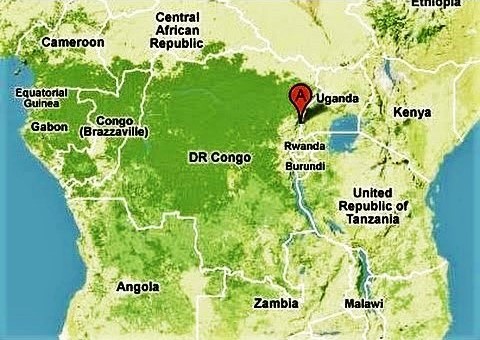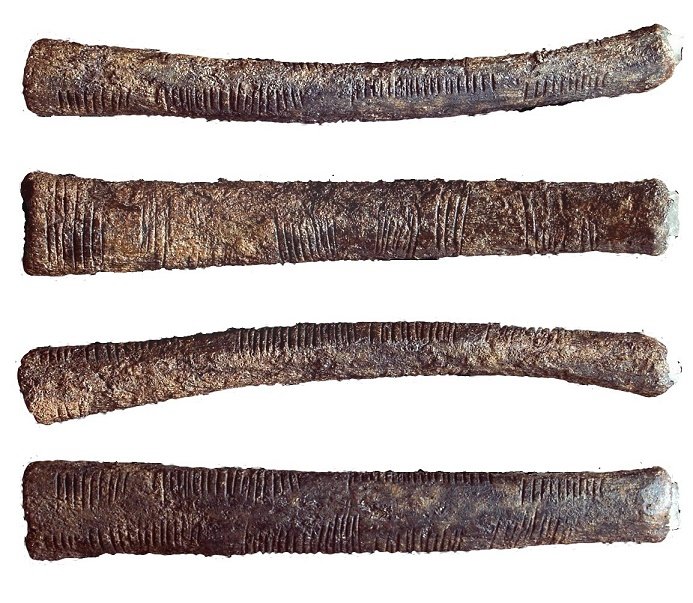Found in Sub-Sahara Africa? Older than the ancient Egyptians?

“Today, however, the more than 20,000 years old Ishango bone is considered to be the first evidence of a calculator in the world, although in the Lebombo mountains of Zwaziland a similar find has been dated to 35,000 years ago. Named after the place where it was found in the Democratic Republic of Congo, the Ishango bone is what is called a bone tool or the cradle of mathematics.”
The Ishango bone was found in 1960 by Belgian Jean de Heinzelin de Braucourt while exploring what was then the Belgian Congo. It was discovered in the area of Ishango near the Semliki River. Lake Edward empties into the Semliki which forms part of the headwaters of the Nile River (now on the border between modern-day Uganda and Congo). The bone was found among the remains of a small community that fished and gathered in this area of Africa. The settlement had been buried in a volcanic eruption.
The artifact was first estimated to have originated between 9,000 BC and 6,500 BC. However, the dating of the site where it was discovered was re-evaluated, and it is now believed to be more than 20,000 years old.
The Ishango bone is a bone tool, dated to the Upper Paleolithic era. It is a dark brown length of bone, the fibula of a baboon, with a sharp piece of quartz affixed to one end, perhaps for engraving. It was first thought to be atally stick, as it has a series of what has been interpreted as tally marks carved in three columns running the length of the tool. It has also been suggested that the scratches might have been to create a better grip on the handle or for some other non-mathematical reason.
The Ishango bone is on permanent exhibition at the Royal Belgian Institute of Natural Sciences, Brussels, Belgium.
Ishango Bone – Mathematics Department of SUNY Buffalo – University …

English subtitles are already included
Mathematical Treasure: Ishango Bone | Mathematical Association
Mathematical calculations:
Some believe the three columns of asymmetrically grouped notches imply that the implement was used to construct a numeral system.
The central column begins with three notches and then doubles to 6 notches. The process is repeated for the number 4, which doubles to 8 notches, and then reversed for the number 10, which is halved to 5 notches. These numbers may not be purely random and instead suggest some understanding of the principle of multiplication and division by two. The bone may therefore have been used as a counting tool for simple mathematical procedures.
In the book How Mathematics Happened: The First 50,000 Years, Peter Rudman argues that the development of the concept of prime numbers could have come about only after the concept of division, which he dates to after 10,000 BC, with prime numbers probably not being understood until about 500 BC. He also writes that “no attempt has been made to explain why a tally of something should exhibit multiples of two, prime numbers between 10 and 20, and some numbers that are almost multiples of 10.”
https://youtu.be/09l2nR3knYk?t=3m53s
The History Of Numbers And Mathematics – The Story Of 1 One Documentary – BBC Documentary Channel A binary code stands for message or computer.
Lunar calendar:
Alexander Marshack examined the Ishango bone microscopically, and concluded that it may represent a six-month lunar calendar; but Judy Robinson argues that Marshack overinterprets the data and that the evidence does not support lunar calendars. Claudia Zaslavsky has suggested that this may indicate that the creator of the tool was a woman, tracking the lunar phase in relation to the menstrual cycle.
Second bone:
During earlier excavations at the Ishango site in 1959, another bone was also found. It is lighter in color and was scraped, thinned, polished, and broken on one end, revealing it to be hollow. The artifact possibly held a piece of quartz like the more well-known bone or it could have been a tool handle. The 14-cm long bone has 90 notches on six sides, which are categorized as “major” or “minor” according to their length. Jean de Heinzelin interpreted the major notches as being units or multiples and the minor notches as fractions or subsidiary. He believed the bone to be an “interchange rule between bases 10 and 12.”
The Prime Glossary: Ishango bone

No Comments Yet